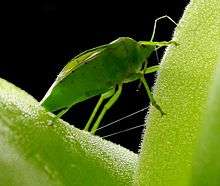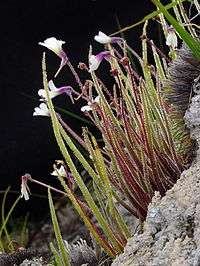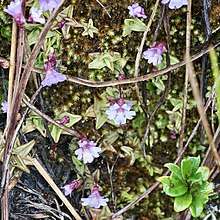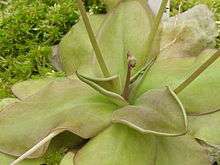List of Pinguicula species
The genus Pinguicula contains the 83 species of butterworts, belonging to the bladderwort family (Lentibulariaceae). It has a natural distribution across most of the Northern Hemisphere, though over half of the species are concentrated in Mexico and Central America. Siegfried Jost Casper systematically divided them into three subgenera with 15 sections. Subsequent phylogenetic research showed that many of these groupings are polyphyletic, but they are used below.
- This article is a list of the butterworts, the species of the genus Pinguicula. For general information on butterworts, please see the main article on Pinguicula.
Subgenus Isoloba

Pinguicula gigantea with prey. The insect was too large and was able to escape.
Section Agnata
- Pinguicula agnata
- Pinguicula albida
- Pinguicula benedicta
- Pinguicula cubensis
- Pinguicula filifolia
- Pinguicula gigantea
- Pinguicula infundibuliformis
- Pinguicula lithophytica
- Pinguicula pilosa
Section Cardiophyllum
- Pinguicula crystallina
- Pinguicula crystallina subsp. hirtiflora
- Pinguicula habilii[1]
Section Discoradix
- Pinguicula casabitoana
- Pinguicula lignicola
Section Heterophyllum

Pinguicula heterophylla
- Pinguicula acuminata
- Pinguicula conzattii
- Pinguicula heterophylla
- Pinguicula imitatrix
- Pinguicula kondoi
- Pinguicula mirandae
- Pinguicula parvifolia
- Pinguicula rotundiflora
Section Isoloba
- Pinguicula caerulea – blue-flower butterwort
- Pinguicula ionantha – Godfrey's butterwort, violet butterwort
- Pinguicula lilacina
- Pinguicula lusitanica – pale butterwort
- Pinguicula lutea – yellow butterwort
- Pinguicula planifolia – Chapman's butterwort
- Pinguicula primuliflora – southern butterwort
- Pinguicula pumila – small butterwort
- Pinguicula sharpii
- Pinguicula takakii
Subgenus Pinguicula
Section Crassifolia
- Pinguicula ehlersiae
- Pinguicula esseriana
- Pinguicula debbertiana
- Pinguicula jaumavensis
Section Homophyllum
- Pinguicula greenwoodii
- Pinguicula jackii
- Pinguicula lippoldii
- Pinguicula toldensis
Section Longitubus
- Pinguicula calderoniae
- Pinguicula crassifolia
- Pinguicula hemiepiphytica
- Pinguicula laueana
- Pinguicula utricularioides
Section Orcheosanthus
- Pinguicula colimensis
- Pinguicula cyclosecta
- Pinguicula elizabethiae
- Pinguicula gypsicola
- Pinguicula macrophylla
- Pinguicula mesophytica
- Pinguicula moctezumae
- Pinguicula moranensis
- Pinguicula oblongiloba
- Pinguicula orchidioides (synonym P. stolonifera)
- Pinguicula zecheri
Section Orchidioides
Section Pinguicula
- Pinguicula balcanica – Balkanian butterwort
- Pinguicula balcanica var. tenuilaciniata
- Pinguicula corsica
- Pinguicula grandiflora – large-flowered butterwort
- Pinguicula grandiflora subsp. rosea
- Pinguicula leptoceras
- Pinguicula longifolia – long-leaved butterwort
- Pinguicula longifolia subsp. causensis
- Pinguicula longifolia subsp. dertosensis
- Pinguicula longifolia subsp. reichenbachiana
- Pinguicula macroceras – California butterwort
- Pinguicula macroceras var. macroceras
- Pinguicula macroceras subsp. nortensis
- Pinguicula mundi
- Pinguicula nevadensis
- Pinguicula poldinii
- Pinguicula vallisneriifolia
- Pinguicula vulgaris – common butterwort
Subgenus Temnoceras
Section Ampullipalatum

Pinguicula calyptrata from Ecuador, Cayambe Coca National Park, 3800 m
- Pinguicula antarctica
- Pinguicula calyptrata
- Pinguicula chilensis
- Pinguicula involuta
- Pinguicula elongata
Section Micranthus
- Pinguicula algida
- Pinguicula alpina – Alpine butterwort
- Pinguicula ramosa
- Pinguicula variegata
Section Temnoceras
- Pinguicula clivorum
- Pinguicula crenatiloba
- Pinguicula emarginata
- Pinguicula gracilis
- Pinguicula immaculata
Incertae sedis
References, external links, and further reading
- H. Yıldırım, S. G. Şenol & A. F. Pirhan (2012). "Pinguicula habilii (Lentibulariaceae), a new carnivorous species from South-West Anatolia, Turkey" (PDF). Phytotaxa. 64: 46–58.
- Casper, S. J.: Monographie der Gattung Pinguicula, (Bibliotheca Botanica, Heft 127/128), 1966, Stuttgart
- Cieslak, Thomas; Polepalli, Jai Santosh; White, Adam; Müller, Kai; Borsch, Thomas; Barthlott, Wilhelm; Steiger, Juerg; Marchant, Adam; Legendre, Laurent (2005). "Phylogenetic analysis of 'Pinguicula (Lentibulariaceae): chloroplast DNA sequences and morphology support several geographically distinct radiations". American Journal of Botany. 92 (10): 1723–1736. doi:10.3732/ajb.92.10.1723. PMID 21646090.
- Schlauer, Jan: Carnivorous Plant Database, version Nov. 15, 16:25.
gollark: Ah, but it has to be bootable *by UEFI/MBR*, that's the hard bit.
gollark: Yes, a valid picture-y image file which can also be booted from.
gollark: You could make a *zip* file which is both bootable and extractable, but that's because of a weird zip quirk.
gollark: Evil idea: somehow make a valid image file you can also boot from if you `dd` it straight to a disk.
gollark: I'd just like to interject for a moment. What you're referring to as Linux,is in fact, GNU/Linux, or as I've recently taken to calling it, GNU plus Linux.Linux is not an operating system unto itself, but rather another free componentof a fully functioning GNU system made useful by the GNU corelibs, shellutilities and vital system components comprising a full OS as defined by POSIX.Many computer users run a modified version of the GNU system every day,without realizing it. Through a peculiar turn of events, the version of GNUwhich is widely used today is often called "Linux", and many of its users arenot aware that it is basically the GNU system, developed by the GNU Project.There really is a Linux, and these people are using it, but it is just apart of the system they use. Linux is the kernel: the program in the systemthat allocates the machine's resources to the other programs that you run.The kernel is an essential part of an operating system, but useless by itself;it can only function in the context of a complete operating system. Linux isnormally used in combination with the GNU operating system: the whole systemis basically GNU with Linux added, or GNU/Linux. All the so-called "Linux"distributions are really distributions of GNU/Linux.
This article is issued from Wikipedia. The text is licensed under Creative Commons - Attribution - Sharealike. Additional terms may apply for the media files.
